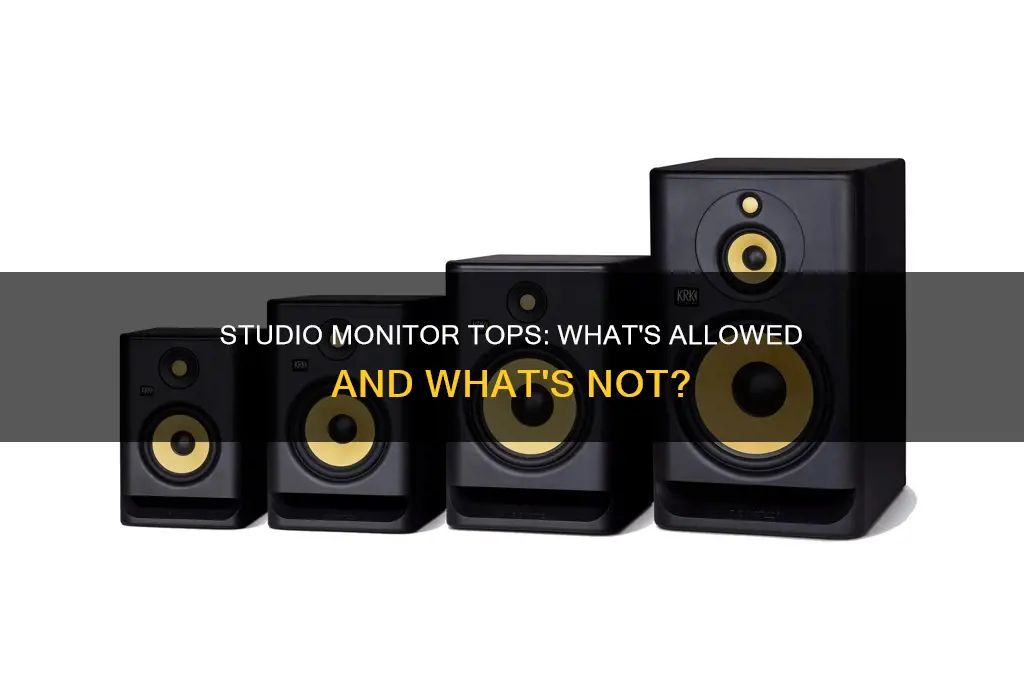
Studio monitors are designed to accurately reproduce audio without any coloration or hype. Optimal monitor placement plays a huge role in establishing an accurate mixing space. While there are several guidelines for ideal monitor placement, such as avoiding long, flat walls and corners, centering your speakers on a wall, and creating a symmetrical room and symmetrical left/right speaker placement, it is also important to consider the impact of placing things on top of studio monitors.
Some people put ornaments, plants, or even a second monitor on top of their studio monitors. While this may not always be advisable, especially if the added weight causes vibrations or rattle, it is generally acceptable as long as it does not break, make noise, or fall off. However, it is recommended to use monitor stands or isolation pads to raise the speakers closer to ear level and prevent early reflections from interfering with the listening environment.
| Characteristics | Values |
|---|---|
| Items on top of studio monitors | Avoid ferrous metal objects, liquids, glass, or anything that could fall off or make noise |
| Studio monitor placement | Away from walls and corners, with the tweeter at ear level |
| Studio monitor orientation | Check the manual, but typically vertical |
What You'll Learn
- Studio monitors should be placed vertically or horizontally depending on the manufacturer's recommendation
- Avoid corners and long, flat walls when placing studio monitors
- Symmetrical room and symmetrical left/right speaker placement is ideal
- Studio monitors should be placed on stands or isolation pads to prevent vibrations and rattling
- The tweeter of the studio monitor should be at ear level

Studio monitors should be placed vertically or horizontally depending on the manufacturer's recommendation
Studio monitors should be placed according to the manufacturer's recommendations, which will ensure optimal sound quality and performance. Some monitors are designed to be placed horizontally, while others are intended for vertical placement only. Placing a vertical speaker horizontally may result in a degraded stereo image as the sound propagation is altered. Therefore, it is essential to refer to the manual or product documentation before setting up your studio monitors.
For example, the PreSonus Eris E5, E44, and E66 studio monitors can be placed either horizontally or vertically. When placed horizontally, these monitors should be positioned as mirror images of each other, with the tweeters on the outside. This configuration ensures that the stereo image remains intact. Similarly, MTM monitors like the Eris E44 and E66, when placed vertically, should also form a mirror image with their tweeters on the outside.
In some cases, placing the speakers vertically may result in the tweeter being aimed above the listener's ears. To address this issue, both monitor speakers can be inverted so that the tweeters are on the bottom. While this may look unusual, it is an effective solution. Additionally, monitor stands can be used to adjust the height and angle of the speakers to achieve the desired sound dispersion.
It is worth noting that while following the manufacturer's recommendations is generally advisable, there is room for experimentation. You may find that a different orientation suits your specific space better, even if it deviates from the manufacturer's guidelines. Ultimately, the goal is to create the best mixing environment for your needs.
Furthermore, there are additional factors to consider when positioning your studio monitors. It is recommended to avoid placing them against walls or in corners, as this can cause unwanted sound reflections and bass buildups. A symmetrical setup is generally preferred, as asymmetrical placement can distort the stereo image. Creating an equilateral triangle between the speaker placement and your listening position will help establish the "sweet spot" for optimal sound.
Best Places to Buy Sound Monitoring Machines
You may want to see also

Avoid corners and long, flat walls when placing studio monitors
When setting up your studio monitors, it's important to consider the impact of the room's geometry and reflective surfaces on sound quality. Placing monitors in corners or against long, flat walls can create issues with sound reflection and frequency response.
Every room has its own set of resonant frequencies, which interact with sound waves to create modes. These modes are influenced by sound reflecting off different surfaces, including walls, ceilings, and floors. The placement of monitors and the listener within this acoustic environment will determine the accuracy of the listening experience.
Corners and long, flat walls should be avoided when positioning studio monitors. Reflections from these surfaces can cause phase cancellations and other unwanted acoustic interactions, particularly in the lower end of the frequency spectrum. This is especially true for rear-ported monitors, where the port at the back allows air from the woofer to escape. The reflected sound waves can interfere with the direct sound from the monitors, creating an uneven bass response and affecting the accuracy of your mixes.
To mitigate these issues, it is recommended to maintain a minimum distance of 20-30 cm (8-12 inches) between the monitors and walls, with a maximum distance of 60-90 cm. This helps reduce sound waves reflecting back to the listening position. Additionally, ensure that the distances between the monitors and the side and back walls are different to avoid creating corners that can further impact sound reflection.
By following these guidelines and carefully considering monitor placement, you can create a more balanced stereo image and achieve a more reliable frequency response, resulting in a more accurate and immersive listening experience.
Camera Location on ASUS Monitors: A Quick Guide
You may want to see also

Symmetrical room and symmetrical left/right speaker placement is ideal
Symmetry is key when it comes to achieving optimal sound quality in a room. The placement of speakers in relation to the listener and the room itself can have a significant impact on the overall sound experience.
The ideal setup for a 2-channel stereo system involves creating an equilateral triangle, with the two speakers and the listener's head forming the three points. This means that the distance between the left and right speakers should be equal to the distance from each speaker to the listening position. This setup helps to create symmetrical sound reproduction, ensuring that the sound reaches the listener's ears directly and minimising any distortions caused by sound reflections off walls or other objects.
To further enhance the stereo effect, it is recommended to angle the speakers slightly inward towards the listening position, a technique known as "toeing-in". This ensures that the sound waves from each speaker reach the listener at the same time, creating a clear and focused centre image.
The height of the speakers is also crucial. Ideally, the speakers should be positioned so that the tweeters (the small drivers handling high-frequency sounds) are at the same height as the listener's ears. This can often be achieved by placing the speakers on stands or shelves, ensuring they are secured to prevent any accidental movement.
In addition to speaker placement, the arrangement of furniture, curtains, and even the choice of flooring can influence sound quality. These elements can affect the absorption and diffusion of sound waves, so it is important to ensure there are no obstacles between the speakers and the listening area.
While achieving perfect symmetry in a room may be challenging, especially in spaces with unique shapes or limited space, it is worth experimenting with speaker placement and room arrangement to find the optimal setup for your specific environment.
Best Places to Buy Marshall Monitor Headphones
You may want to see also

Studio monitors should be placed on stands or isolation pads to prevent vibrations and rattling
Monitor stands can also help to prevent vibrations and rattling by raising the speakers above the desk. This has the added benefit of bringing the speakers closer to ear level, which is optimal for hearing high-frequency content. If your speakers are placed on a desk, they may be below ear level, which is not ideal.
In addition to preventing vibrations and rattling, using stands or isolation pads can also help to improve the sound quality of your studio monitors by reducing early reflections from your desktop, which is a hard, reflective surface.
It's worth noting that some people choose to place items on top of their studio monitors, such as ornaments or PC monitors. While this may not be advisable due to the risk of vibrations and rattling, some people suggest that as long as the items don't touch the cones, fall off, or make noise, it should be fine. However, it's generally recommended to use stands or isolation pads to ensure optimal sound quality and prevent any potential damage to your studio monitors.
When is the Release Date of that HP Monitor?
You may want to see also

The tweeter of the studio monitor should be at ear level
The tweeter of a studio monitor should be at ear level to ensure optimal sound quality. This is because the tweeter produces high-frequency sounds that need to be directed at the listener's ears for the best listening experience. Placing the tweeter at ear level also helps to create a wider sweet spot, allowing for more movement side to side without losing sound quality.
While it is generally recommended to have the tweeter at ear level, there are some exceptions and workarounds. For example, if the studio monitor has a round tweeter waveguide, it can be used horizontally, as the sound distribution will be relatively consistent in all directions. Additionally, if the studio monitor is placed too low, it can be tilted upwards using speaker mounts or foam pads to angle the tweeter towards the listener's ears.
The height of the woofer, or low-frequency driver, is also important to consider. Placing the woofer at ear level or higher can cause issues with low-end frequencies due to the distance from the floor and ceiling, resulting in unwanted modes. However, this can be mitigated by angling the studio monitor downwards so that the tweeter is still pointed at the listener's ears.
Overall, it is important to follow the manufacturer's directions and consider the specific design of the studio monitor, the room setup, and personal preference when positioning the tweeter at ear level.
LCD Monitor Lifespan: How Long Can You Expect?
You may want to see also
Frequently asked questions
It is not recommended to place a PC monitor on top of a studio monitor as it may damage the studio monitor. It is suggested to use a monitor stand or mount instead. However, if the PC monitor is light and secure, some people believe it should be fine.
It is not recommended to place ornaments on top of studio monitors as they may rattle or make noise, especially if they are made of ferrous metal. However, some people believe it is fine as long as the ornaments do not break, make noise, or fall off.
It depends on the specific studio monitor. Some monitors can be placed in either orientation, while others should only be used vertically. Placing a vertical speaker horizontally may mess up the stereo image. It is recommended to consult the manual for the specific studio monitor.
It is not recommended to place studio monitors right up against a wall as it can create unwanted wall noise and affect the stereo image. It is suggested to place the studio monitors at least 6 to 10 inches away from the wall, with the ideal distance being 2 to 3 feet.







